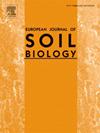有机肥替代没有改变生物炭对细菌群落稳定性的主导作用,但改变了土壤碳组分
IF 3.3
2区 农林科学
Q1 ECOLOGY
引用次数: 0
摘要
使用生物炭和有机肥来提高土壤的碳潴留。然而,生物炭与有机肥在不同水平上稳定土壤有机碳的交互作用尚不清楚。生物炭的田间施用试验(干燥土壤的0%、1%和2%);对照,LB和HB分别)和有机肥替代(无机氮的0%,20%,40%和60%;分别以T0、T2、T4和T6(发酵羊粪代替尿素- n)为试验条件,探讨其作用机制。土壤有机碳(SOC)、颗粒有机碳(POC)和矿物伴生有机碳(MAOC)含量随生物炭添加和有机肥替代的增加而增加。表层土壤(0 ~ 15 cm) SOC值为17 ~ 24 g kg - 1, POC值为2.03 ~ 6.6 g kg - 1, MAOC值为15 ~ 19 g kg - 1。深层土壤(16 ~ 30 cm)土壤有机碳(SOC)为16 ~ 20 g kg−1,POC为1.2 ~ 3.4 g kg−1,MAOC为14 ~ 18 g kg−1。与单独使用生物炭相比,HB联合有机肥替代对SOC、POC和MAOC的提高效果更好。表层土壤中β-1,4-葡萄糖苷酶和纤维素生物水解酶(CBH)活性是底土的1.2 ~ 1.6倍。增加生物炭通过限制CBH活性降低POC/MAOC比率(P <;0.05)。有机肥替代通过减轻生物炭对土壤层内细菌生物量的限制,提高了POC/MAOC比值。细菌群落组成随生物炭添加量和土壤层数的变化显著(P <;0.05)。生物炭增强了非均质选择的优势作用,增加了表层土壤和底土细菌网络的复杂性。基于结构方程模型,细菌负/正内聚力的增加显著提高了表土中MAOC的比例(P <;0.05)。该研究提供了证据,证明生物炭(而不是有机肥替代)通过降低CBH活性和细菌生物量以及提高网络复杂性来提高碳储量。因此,在评价农业实践对有机碳库的动态影响时,必须考虑土壤层位。本文章由计算机程序翻译,如有差异,请以英文原文为准。
Substitution of organic fertilizer did not change the dominant role of biochar on bacterial community stability but the soil carbon fractions
Biochar and organic fertilizers are used to improve soil carbon retention. However, the interactive roles of biochar and organic fertilizer in stabilizing soil organic carbon (SOC) at different horizons remain unclear. A field experiment with biochar application (0 %, 1 %, and 2 % of dry soil; Control, LB, and HB, respectively) and organic fertilizer substitution (0 %, 20 %, 40 %, and 60 % of inorganic N; T0, T2, T4, and T6, respectively) (fermented sheep manure replacing urea-N)) was conducted to reveal the mechanisms. The SOC, particulate organic carbon (POC), and mineral-associated organic carbon (MAOC) contents increased with the biochar addition and organic fertilizer substitution. In the topsoil (0–15 cm), values ranged from 17 to 24 g kg−1 (SOC), 2.03–6.6 g kg−1 (POC), and 15–19 g kg−1 (MAOC). In the subsoil (16–30 cm), the ranges were 16–20 g kg−1 (SOC), 1.2–3.4 g kg−1 (POC), and 14–18 g kg−1 (MAOC). HB combined with organic fertilizer substitution promoted SOC, POC, and MAOC more effectively than biochar alone. The β-1,4-glucosidase and cellobiohydrolase (CBH) activities in the topsoil were 1.2–1.6 times higher than those in the subsoil. Increases in biochar reduced the POC/MAOC ratio by limiting CBH activity (P < 0.05). Substituting organic fertilizer increased the POC/MAOC ratio by alleviating the limitation of biochar on bacterial biomass in the soil horizons. Bacterial community composition varied significantly with biochar addition and between soil horizons (P < 0.05). Biochar enhanced the dominant role of heterogeneous selection and increased bacterial network complexity in both the topsoil and subsoil. Based on structural equation modeling, an increase in bacterial negative/positive cohesion significantly improved the proportion of MAOC in the topsoil (P < 0.05). This study provides evidence that biochar (but not organic fertilizer substitution) helped improve C storage by decreasing the CBH activity and bacterial biomass, and enhancing network complexity. Thus, it is essential to consider soil horizons when evaluating the dynamic effects of agricultural practices on SOC pools.
求助全文
通过发布文献求助,成功后即可免费获取论文全文。
去求助
来源期刊

European Journal of Soil Biology
环境科学-生态学
CiteScore
6.90
自引率
0.00%
发文量
51
审稿时长
27 days
期刊介绍:
The European Journal of Soil Biology covers all aspects of soil biology which deal with microbial and faunal ecology and activity in soils, as well as natural ecosystems or biomes connected to ecological interests: biodiversity, biological conservation, adaptation, impact of global changes on soil biodiversity and ecosystem functioning and effects and fate of pollutants as influenced by soil organisms. Different levels in ecosystem structure are taken into account: individuals, populations, communities and ecosystems themselves. At each level, different disciplinary approaches are welcomed: molecular biology, genetics, ecophysiology, ecology, biogeography and landscape ecology.
 求助内容:
求助内容: 应助结果提醒方式:
应助结果提醒方式:


